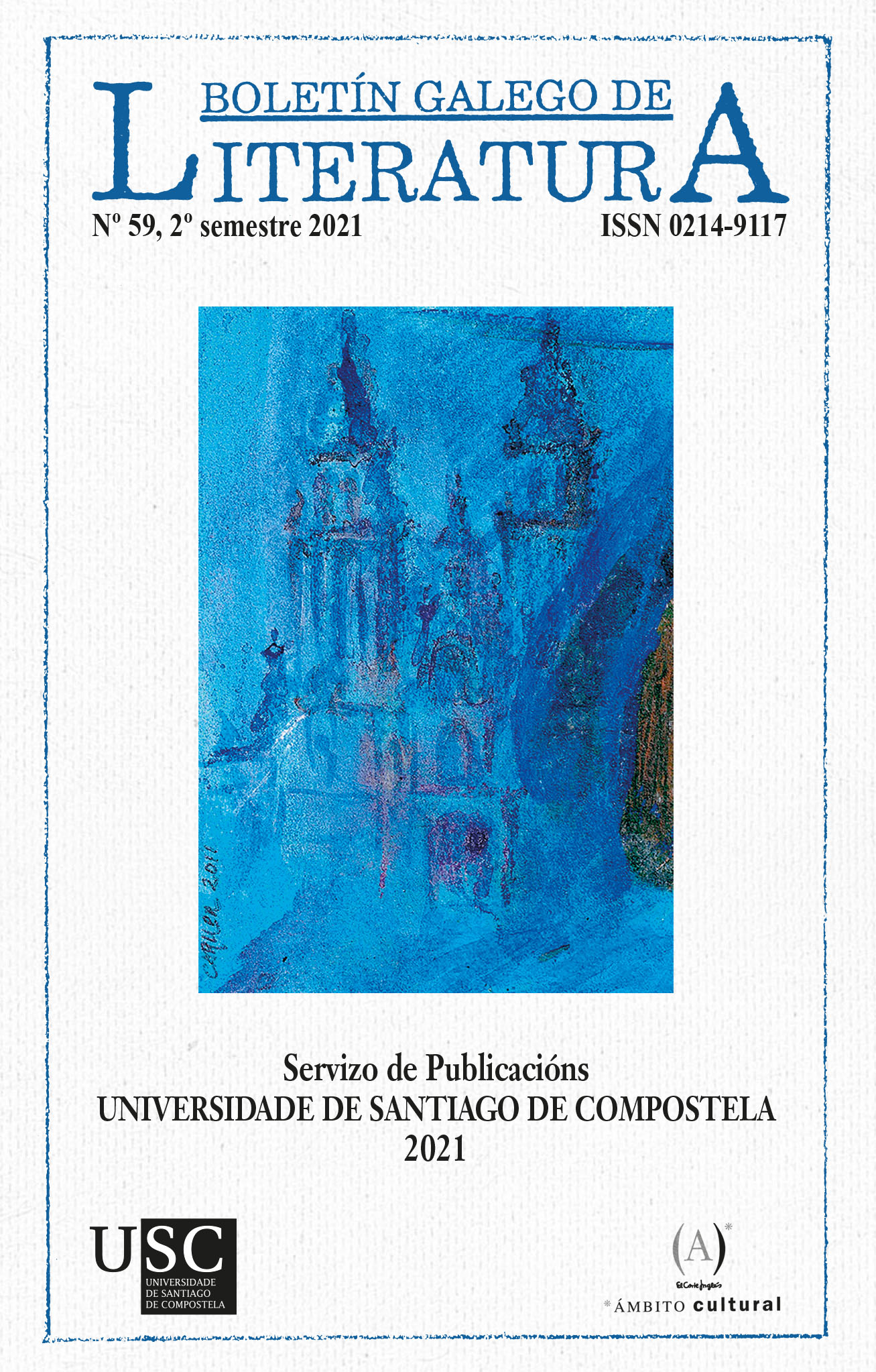A porta de palla or the alternative vision of Santiago de Compostela by Vicente Risco
Main Article Content
Abstract
This study proposes that Vicente Risco's novel A porta de palla constitutes the recreation of an alternative history based on the construction of Nerbia as a counterfactual or alternative space of Santiago de Compostela. In order to corroborate this hypothesis, the novel is analysed from the assumptions of literary cartography, which are based on the supposition of the existence of an interrelation between the empirical world and fictional spaces. Thus, on the basis of the narrative characteristics of each place, a series of typologies are established to determine their correspondence with real geography, according to their cartographic representation possibilities. Finally, on the basis of the maps resulting from this analysis, which allow us to corroborate the initial assumption, we study how the gestation of the alternative space entails the development of new assumptions about History.
Keywords:
Article Details
References
Albrecht, A. e Danneberg, L. (2011). First Steps Toward an Explication of Counterfactual Imagination. En D. Birke, M. Butter e T. Köppe (Eds.), Counterfactual thinking – Counterfactual writing (pp. 12-19). De Gruyter.
Besse, J-M. (2017). Cartographic Fiction. En A. Engberg-Pedersen (Ed.), Literature and Cartography. Theories, Histories, Genres (pp. 21-43). The MIT Press.
Bulson, E. (2010). Novels, maps, modernity: the spatial imagination, 1850- 2000. Routledge.
Cabo Aseguinolaza, F. (2020). Ficción y lugar: los topónimos desde la teoría de la literatura. En O. M Silvestre e R. Patrício (Eds.), Conferências do Cinquentenário da Teoría da Literatura de Vítor Manuel Aguiar e Silva (pp. 153-173). Universidade do Minho.
Compostela geoliteraria (2017). Santiago de Compostela, España. https://www.compostelageoliteraria.org/
Danto, A. C. (1965). Analytical Philosophy of History. Cambridge University Press.
Hillebrand, B. (1971). Mensch und Raum im Roman. Studien zu Keller, Stifter, Fontane. Mit einem einführenden Essay zur europäischen Literatur. Winkler.
Kemp, K. K. (2010). Geographic Information Science and Spatial Analysis for the Humanities. En D. J. Bodenhamer, J. Corrigan e T. M. Harris (Eds), The Spatial Humanities: GIS and the Future of Humanities Scholarship (pp. 31-57). Indiana University Press.
Piatti, B. (2008). Die Geographie der Literatur: Schauplätze, Handlungsräume, Raumphantasien. Wallstein.
Piatti, B. (2017). Literary cartography: mapping as method. En A. Engberg-Pedersen (Ed.), Literature and Cartography. Theories, Histories, Genres (pp. 45-72). The MIT Press.
Piatti, B. e Hurni, L. (2009). Mapping the Ontologically Unreal – Counter- factual Spaces in Literature and Cartography. The Cartographic Journal, 46(4), 333-342. https://doi.org/10.1179/000870409X12554350947386
Piatti, B. e Hurni, L. (2011). Cartographies of fictional worlds. The Cartographic Journal, 48(4), 218-223. https://doi.org/10.1179/174327711X13190991350051
Piatti, B., Bär, H. R., Reuschel, A. K., Hurni, L. e Cartwright, W. (2009). Ma- pping literature –towards a geography of fiction. En W. Cartwright, G. Gartner e A. Lehn (Eds.), Cartography and Art (pp. 177-192). Springer.
Piatti, B., Reuschel, A. K. e Hurni, L. (2009a). Literary Geography – or How Cartographers Open up a New Dimension for Literary Studies. En 24th International Cartographic Conference, Santiago de Chile, Chile.
Plini, P., Di Franco, S. e Salvatori, R. (2016). One place one name? Dealing with toponyms in WWI. GeoJournal, 83, 87-99. https://doi.org/10.1007/s10708-016-9760-9
Reuschel, A-K. e Hurni, L. (2011). Mapping Literature: Visualisation of Spatial Uncertainty in Fiction. The Cartographic Journal, 48(4), 293-308. https://doi.org/10.1179/1743277411Y.0000000023
Risco, Vicente (1920). Teoría do Nacionalismo galego. Fundación Vicente Risco.
Risco, Vicente (1953). La puerta de paja. Planeta.
Risco, Vicente (1981). Obra completa 2. La puerta de paja. Gamalandalfa. La verídica historia del niño de dos cabezas de Promonta. Akal.
Risco, Vicente (2020). A porta de palla. Dr. Alveiros, Fundación Vicente Risco.
Rozas Arceo, Alba (2019). Fragmentos de Apocalipsis como ficción espacial. La condición contrafactual de Villasanta de la Estrella. Un análisis desde la cartografía literaria [Tese de doutoramento]. Universidade de Santiago de Compostela. http://hdl.handle.net/10347/23195
Schögel, K. (2003). Im Raume lesen wir die Zeit: Über Zivilisationsgeschichte und Geopolitik. Carl Hanser Verlag.
Soldevila Durante, I. (1996). Historia e ficción en La puerta de paja. En C. Casares (Ed.), Vicente Risco: actas do Congreso celebrado en Ourense os días 18, 19, 20 e 21 de outubro de 1995 (pp. 301-320). Xunta de Galicia.
Staley, D. J. (2007). History and Future: Using Historical Thinking to Imagine the Future. Landham. Lexington Books.
Ungern-Sternberg, A. (2009). Dots, lines, areas and words: Mapping literature and narration (With some remarks on Kate Chopin’s “The Awakening”). En W. Cartwright, G. Gartner e A. Lehn (Eds.), Cartography and Art (pp. 229–252). Springer.
Weigel, S. (2002). Zum “topographical turn”. Kartographie, Topographie und Raumkonzepte in den Kulturwissenschaften. Kulturpoetik, 2(2), 151-165. https://www.jstor.org/stable/40621671
Widmann, A. M. (2011). Plot vs. Story: Towards a Typology of Counterfactual Historical Novels. En D. Birke, M. Butter e T. Köppe (Eds.), Counterfactual thinking – Counterfactual writing (pp. 170-189). De Gruyter.
Most read articles by the same author(s)
- Alba Rozas Arceo, The figure of the fugitive in galician postwar literature , Elos: Revista de Literatura Infantil e Xuvenil: No 1 (2014)
- Alba Rozas Arceo, The Hobbit: a cartographic adventure , Elos: Revista de Literatura Infantil e Xuvenil: No 1 (2014)
- Alba Rozas Arceo, The Hobbit from a Critical Literary Geography Point of View: Perspectives of Analysis , Boletín Galego de Literatura: No 47 (2015)
- Alba Rozas Arceo, Blanca-Ana Roig Rechou (coord.). 2015. Historia da Literatura Infantil e Xuvenil Galega. Vigo: Edicións Xerais de Galicia. 503 pp. , Boletín Galego de Literatura: No 47 (2015)
- Alba Rozas Arceo, As mulleres como axentes literarias na LIX do século XXI , Elos: Revista de Literatura Infantil e Xuvenil: No 7 (2020)






